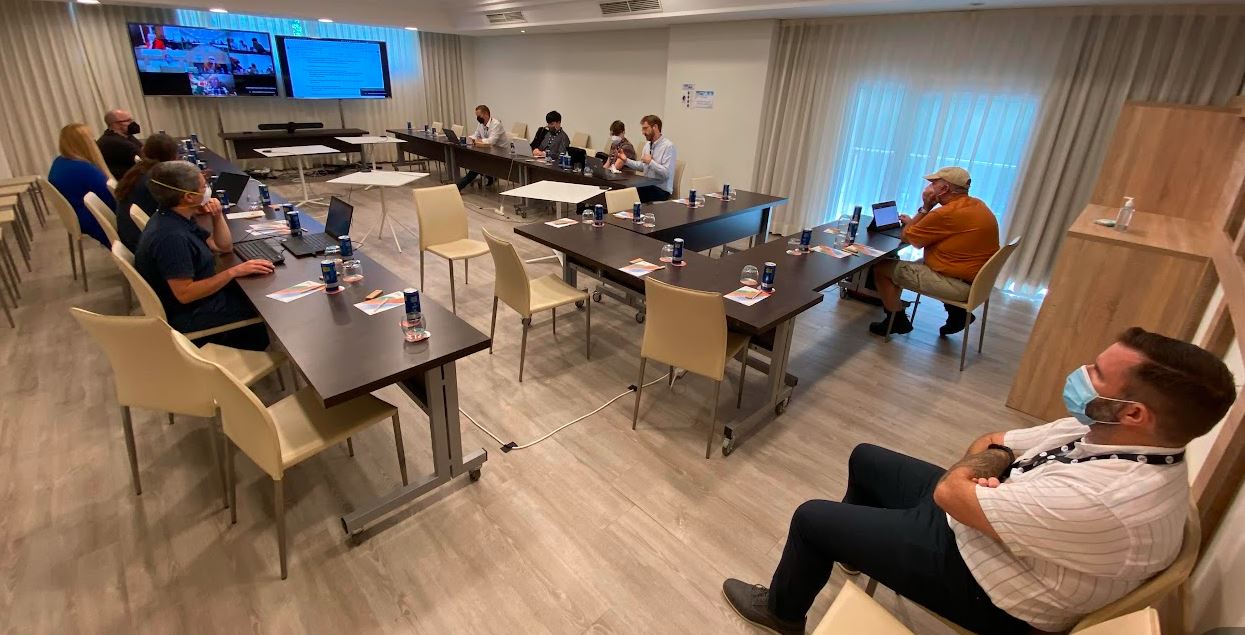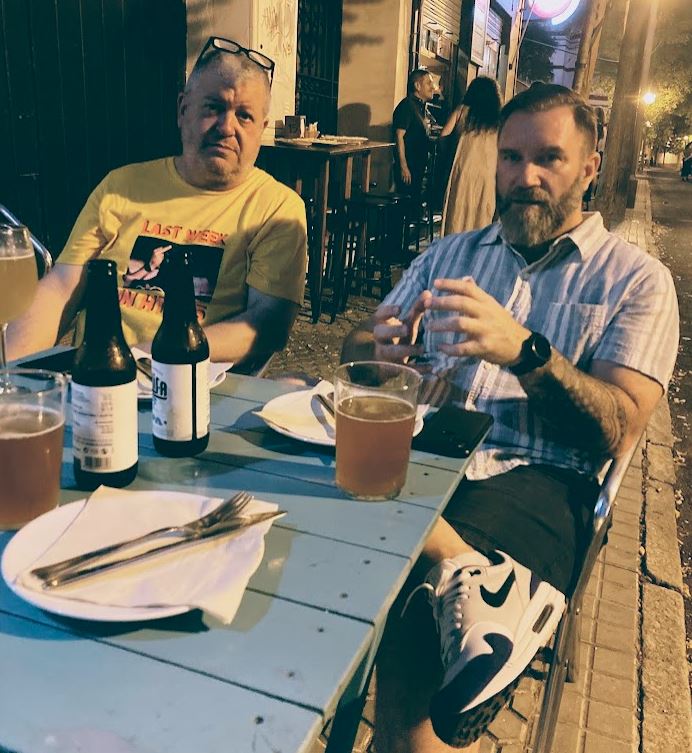
How can we help users with cognitive and learning disabilities navigate around sites more easily? How can we benefit from embracing haptics as another output modality for web content? What do comics and audio dubbing have in common?
The answers, or at least the beginnings of solving them, emerged for each of these questions at W3C’s annual conference, “TPAC.”
Held in the beautiful city of Seville, Spain from September 11-15, 2023, the W3C’s annual conference brings technical contributors together, through in-person and remote collaboration, for in-depth discussion and work on key issues and explorations around the web platform. The power and value of real-time collaborative work—even for an organization that excels at asynchronous activity—can’t be underestimated. Plus, meeting and catching up with dear colleagues is always welcome and motivating, and the camaraderie is excellent.
How TPAC is Structured to Make Progress
The conference consists of a series of intra- and inter-Working Group meetings, each focusing on areas of technical work or decision-making, with shorter, focused “breakout” sessions tackling a specific issue. The breakouts can be proposed and run by any member of W3C and can be made available for the public. The Working Group meetings tend to have a pre-arranged agenda geared toward hands-on work for a specific area. Breakout sessions are centered around presenting and discussing emerging ideas at a high level. Additionally, TPAC has a small selection of meetings focused on the governance and strategy of the W3C as a whole.
TPGi has a wide range of people who contribute to W3C activities. This year, we sent a crew of four to support the following groups:
- Accessibility Guidelines: specifically the application of WCAG to non-web contexts, but also general guidelines work
- Accessible Platform Architectures (APA): accessibility reviews of W3C specs and original work in a range of areas
- Accessibility Education and Outreach: resources for awareness and understanding of accessibility and support for the accessibility work of other W3C Groups
- W3C Advisory Committee
The rest of this article gives a flavor of the accomplishments made during this year’s conference and gives a preview on where the work may go in the future.
Speaking of the future: this year was quite a “blue sky” TPAC, as several groups have either recently published a major update to their standards, or are just about to (including EPUB 3.3, ARIA 1.2, and WCAG 2.2, to name a few). This gave us the chance to explore some more aspirational areas and actually resulted in some exciting near-term work too.
The Fundamentals of Navigation Within Books and Media
The Accessibility Professionals Association (APA) held meetings with a set agenda of issues that had been prepared in conjunction with related functional groups in the preceding months. These often took the form of GitHub issue threads arising from our review of other specifications, or notes on our desire to work with other groups to update their specs to cater for accessibility needs identified since their last major revision.
During our discussions both with the EPUB Working and Community Groups and the Media and Entertainment Interest Group and Time Text Working Group, we talked about the needs we had identified for navigating interlinear texts (i.e. texts where you have different languages interweaved). This issue often arises when a user might be learning a language or seeking help to interpret an ancient text, and helps improve structural navigation within media. In DAISY books, for example, we choose to go back or forward, and we can do this at different levels of granularity, such as sections, chapters, or parts. We would like to be able to do the same in other media, like video, to skip a scene, or act, for example.
These concerns apply to studies of ancient and venerated religious texts, and comics and manga, as suggested by our publishing friends. Further, our partners in various media groups surmised that there may be some fundamental similarities between those digital book navigation use cases, and the different granularities, or hierarchy, of navigation we were requesting for audio-video media.
One of the great challenges in standards work and computing in general is solving problems “at the right layer [of abstraction]”—where its fundamental root lies. Solving a problem at too high of a level can result in duplicative work: multiple groups may be trying to solve the same underlying challenge within their own very specific high-level domains, so the work can’t easily be shared. It can also result in incompatible approaches to what should have been the same solution.
However, solving a problem at an artificially low level can cause unnecessary complications, often resulting in a solution that is both too complex and potentially unreliable, because it tries to tie together too many concepts that aren’t all related.
The excitement about this realization about navigation is that it didn’t just come from us. There’s a greater chance that we are trying to explore at the right level—and that we can learn from the techniques developed in the EPUB and DAISY world to make navigation in other media more flexible and accessible for everyone. Time will tell, of course, but it’s exciting to be embarking upon this exploration together. We agreed to pursue this possibility together and keep our respective groups updated.
Learning From Outside work: Embracing Haptic Output
One of the breakout sessions centered on the scope of haptics to improve accessibility and engagement with apps. This was work led by a team from Tencent. In the APA Working Group, we benefited from a follow-up discussion with the team’s lead, Harry Wang, on how we might work together to further the development of haptics—particularly the modern, high-resolution style of haptic feedback available in settings such as games consoles—on the web platform.
One of APA’s jobs is to help coordinate accessibility efforts, so we were thrilled to have this discussion. We identified several steps to take to investigate the apparent gap in the web platform and how we might resolve it. These include working with other groups who have an interest in haptic capabilities or are developing related standards.
Building on Existing Architecture to Make Site Navigation More Accessible
Sometimes, we find solutions to our problems serendipitously by studying solutions found for other problems. When APA was asked to review A Well-Known URL for Changing Passwords, it became apparent that the idea of “well-known” URLs might help us make site navigation easier for people with cognitive accessibility barriers. From the Cognitive Accessibility Task Force, we know that there are a range of common destinations users might want to visit on a site. But when they’re expressed with a different design language or terminology, they can be hard for users to find.
We envisaged a series of well-known URLs that could be used to solve this problem: for each common destination that might exist (e.g. login, search, product listing, the accessibility statement, and so on), there would be a matching well-known URL. Visiting the URL would take the user to the corresponding common destination. We could envisage a browser extension (or ultimately, UI within the browser) that would offer a choice of destinations in a familiar way, so they wouldn’t have to navigate around the site.
In situations like these, we would want to enumerate the well-known destinations supported by a particular site, and we would want to do so efficiently (i.e. in one HTTP request). For this, we invited an expert from the Web App Security Working Group to advise us on the architectural issues. We received some very helpful advice on how to create an efficient solution and encouragement that the problem we were aiming to solve represented a good reason to specify the well-known destinations for all users. Thanks to this, we will be drafting a specification shortly.
Additionally, we found it encouraging that two groups within W3C, the Adapt Task Force and the Accessibility at the Edge Community Group, both wanted to solve it for different reasons. The Edge group’s motivation, for example, focuses on the provision of human and machine-readable accessibility statements. Further, we received a similar proposal regarding the creation of a well-known URL for accessibility statements from two external contributors. We are now all working together to build a specification that has consensus and, thanks to the advice we’ve had, builds in a robust way on existing web infrastructure.
Working Together to Teach the Fundamentals of Testing for Accessibility
When you’re amongst a sea of web standards and web accessibility experts, it can be easy to geek out in the myriad of nuanced discussions about haptics and well-known URIs. Thankfully, the Accessibility Education and Outreach Working Group (EOWG) always has an eye on those who are new to accessibility and need some extra resources.
This year, one of our main goals was to advance the work on our Easy Checks resource. This resource has been around for some time but is in need of a major update and refresh to ensure it’s meeting users’ standards.
Easy Checks is a resource for people that have limited knowledge of accessibility but still need the ability to evaluate a website’s basic compliance. Think of someone in procurement who has to narrow down a list of potential providers to those that have ensured at least a minimal level of accessibility. Or a product owner who has just received the first prototype of a product and wants to make sure accessibility has been considered. Or, even, an employer who wants to see if a candidate’s website has accessibility built in.
One of the challenges that we have with Easy Checks is deciding what should be included. What would be relatively easy to assess that also improves the experience for users with disabilities? Also, what checks could be done with tooling, such as bookmarklets, to reduce the manual testing aspects?
We reviewed new page layouts and sample content to put the user first and ensure that the checks were going to be as easy as possible.
Prior to TPAC, a list of checks was assembled and ranked according to the ease of check, the ease of explanation, and the impact on users. After reviewing the page layouts, we took the results of this list and did a combination of in-person and virtual card sorting to put these checks into logical groups. This really let the EO group vet the checks as we considered the users we are targeting, like the procurers and employers.
While there is still a lot of work to be done, the activities were a success and pushed us much further towards completing the project. Hopefully, this will be another fantastic W3C Web Accessibility Initiative resource that will be referenced for many years!
Working Towards WCAG 3
TPAC marked the first time we worked on WCAG 3 with the Accessibility Guidelines Working Group.
The week was very hands-on, with up to ten people contributing simultaneously to each scratchpad document, hashing out different perspectives in real-time. We put many hours of hands-on effort into five documents, taking particular care that our use cases could apply equally to web and non-web content, such as native apps on platforms from smartwatches to smart TVs, in accordance with the mandate of the WCAG2ICT Task Force that applies WCAG 2.2 to non-web documents and software.
We are still in the early stages of WCAG 3, but the working group is full steam ahead.
Turning Networking into Evolution
Some of the most productive moments were outside of the sessions. We were able to talk to experts from around the world, who generously let their coffee get cold while we hashed out what would otherwise be difficult problems.
A few interesting conversations to note:
- We brainstormed with several people on how to evaluate text resizing in native applications (desktop, mobile, watch) to support users with low vision. This included a person who “wrote the book” on CSS, and a participant who has low vision.
- After getting acquainted in the AI Ethics meeting, a senior technology leader from Apple put us in contact with people working on text legibility on smart TVs.
TPAC 2023 Takeaways
There are many ways in which groups work at TPAC, just as there are many problems that we can solve more quickly with a concerted effort, especially when we’re face-to-face. Getting together in this way, even virtually, creates the opportunity to get work done with a high level of focus and to serendipitously discover the connections that might turn into novel solutions to future challenges.
TPGi continues to support a wide range of standards activities along with our colleagues across the industry. We look forward to continuing this collaborative work to support progress on the web.
Further info links
- Breakouts – some of which are public (minutes and videos pending): https://www.w3.org/2023/09/TPAC/breakouts.html
- 2022 public breakout archive: https://www.w3.org/2022/09/TPAC/breakouts.html (session recordings available for some)
- 2021 public breakout archive: https://www.w3.org/2021/10/TPAC/breakouts.html (session recordings available for some)
Planning details for interest
- APA TPAC 2023 wiki page: https://www.w3.org/WAI/APA/wiki/Meetings/TPAC_2023
- EO TPAC 2023 wiki page: https://www.w3.org/WAI/EO/wiki/EOWG_F2F_September_2023



